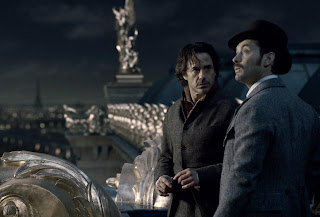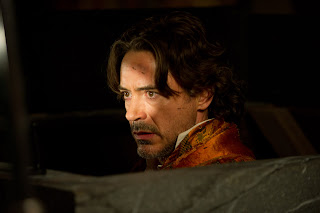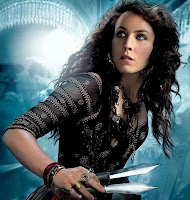For about 45-50 minutes,
Contagion had me ready to run home, duct-tape the seals of my house and never come into contact with a human being again. Steven Soderbergh's detached, "so this is how the world ends" direction and and crisp, clinical cinematography effectively built fear through a steady profession of paranoia escalating from backdoor, classified whispers over vague data to full-on societal panic. Soderbergh's classical style makes even his transcontinental montage intelligible, and his experiments with asynchronous sound and image separates the aesthetic from the action even more, giving it a paradoxically compelling flatness that reminded me of the purportedly meek delivery Jonathan Edwards gave to the fiery words of his "Sinners in the Hands of an Angry God," a mild intellectual remove that only makes the impact that much more powerful.
Then, cracks started to form.
Contagion boasts the largest, most geographically disconnected cast of any of his films since
Traffic, a film that shares more than a few stylistic and structural traits with
Contagion and even seems the thematic inverse of this movie. But like
Traffic,
Contagion spreads itself too thin, across too many people and too many locations without being reliant upon any of them. The emotional distance of such incessant cross-cutting gives way to a belated, almost arbitrary stab at sentimentality that burdens Soderbergh's film with calculated schmaltz that clashes garishly with the studious, medical examiner feel of the rest of the movie. Funnily enough, this is the rare film that actually suffers for its attempts at humanity.
Much more gripping is the methodical progression of the disease from the first seconds. Soderbergh does not even get past the opening black screen before the film without inserting the ragged cough of Beth Emhoff (Gwyneth Paltrow). When the image starts, we see Paltrow looking like hell, a decidedly unglamorous view of an A-lister that kicks off the eerie feel of the impersonality of a disease spread. Anyone susceptible, regardless of notoriety, can get sick, and this new strain works with horrific speed. In only a few minutes of screen time, not only is Beth dead but her young son, leaving her apparently immune husband, Mitch (Matt Damon), bewildered, quarantined for testing and inconsequential to the rapid spread of the virus as it hops continents in the span of hours.
Paltrow and Damon are merely the tip of the iceberg for
Contagion's loaded all-star cast. Marion Cotillard, Laurence Fishburne, Kate Winslet, Bryan Cranston, Elliott Gould, John Hawkes and more fill the screen in various roles as members of the World Health Organization and the Centers for Disease Control monitor the outbreak and head out into the field to study and contain the outbreaks. Where did Soderbergh hold auditions, Spago? That so many would line up for a film that is truly about an invisible presence, making them secondary forces and pawns for the true "protagonist," is a testament to Soderbergh's drawing power, and for a time he keeps us guessing as to who will survive.
Soderbergh gave the Red digital camera a major demonstration in the form of his two-part
Che, and he further demonstrates its range and clarity here.
Che was a film of natural colors used to thematic effect, the bright sunlight of
The Argentine and the overcast, muted tones of
Guerrilla communicating the shifting dynamic of the separate revolutionary campaigns. Here, Soderbergh crafts a half-sick, half-sterile aesthetic of grimy artificial light captured in unflattering realism, clarifying every pore, every clammy hand and spittle flecked mouth until the extreme close-ups of human contact and pulled back shots of the isolation of the survivors ensures we feel equally uncomfortable in crowded areas of potential hosts and alone as society crumbles. Woozy camera movement and quick cuts to hands grasping bus poles or passing around food make the implications even more nauseating, while the icy blue pall that hangs over funereal shots of mass graves and tattered masses lining up for anything even suspected of being a cure emphasizes the distancing horror of death on an epic scale.
Also worth a mention is the electronic score from longtime Soderbergh collaborator Cliff Martinez. Not as dynamic as some recent electronic scores (say, the ones for
The Social Network and
Hanna), Martinez's soundtrack nevertheless proves a driving element of the film, particularly given the lack of true character propulsion. If repetitive, the score works well for finding the perfect aural balance of scuzzy, frantic buzz and quarantined sterility that fits both the clinical official response and growing sickness and collapse on the streets. The sound mix of many of Soderbergh's connecting montages rely almost exclusively on Martinez's cold burbles and hums, and they keep the movie going well after the visual juxtapositions start to grow thin.
But grow thin they do, and eventually the film tries to eke emotional responses out of characters heretofore represented as only as impersonal reactors to the spread of the disease. A subplot involving Jude Law as a firebrand blogger whose anti-Establishment crowing perhaps hides a keen willingness to exploit capitalism to the fullest seeks to show the profiteering and misinformation that befall and propel mass panics. However, as everyone in the cast is so cut off from one another that Law's effects are felt only in the background and the extent to which he makes things worse is never made clear. We're also made to care about Fishburne as the CDC director who makes an all-too-human mistake at a time when complete classification is necessary to keep the peace. Worst of all is Mitch's plotline, which not only saddles the poor man with the deaths of his wife and stepchild but deals with infidelity and adds the useless subplot of his surviving daughter, who regards the 21st century equivalent of the Black Death as, like, a total drag.
My wavering support nearly collapsed in the final half-hour, at which point plotlines began to sag and cease without any pretense at resolution, late-stage sentimental dross like Mitch's daughter pining for her boyfriend suddenly blossomed and a montage coda clarified that which did not truly require clarification. Furthermore, the initial vulnerability of the A-listers eventually gives way to a pat immortality that ensures as many famous people as possible stay on til the end. I still enjoyed
Contagion; watching Soderbergh do his thing was more entertaining than most of this summer's offerings, and occasionally he found ways to ground his epic scope into something gripping. The end, however, turns a chilly take on a grimy genre film into a wannabe prestige picture with what I could swear was an environmentalist message the one time such a message just does not apply. In fairness, I can't think of any way that
Contagion might have ended in wholly satisfactory fashion, but the perfunctory optimism of Hollywood undermines a daring, unsettling and initially unsparing view of humanity's mass reduction. In retrospect, the awkward late-film shift in tone is less surprising than anyone allowing the first hour and 20 minutes.




















